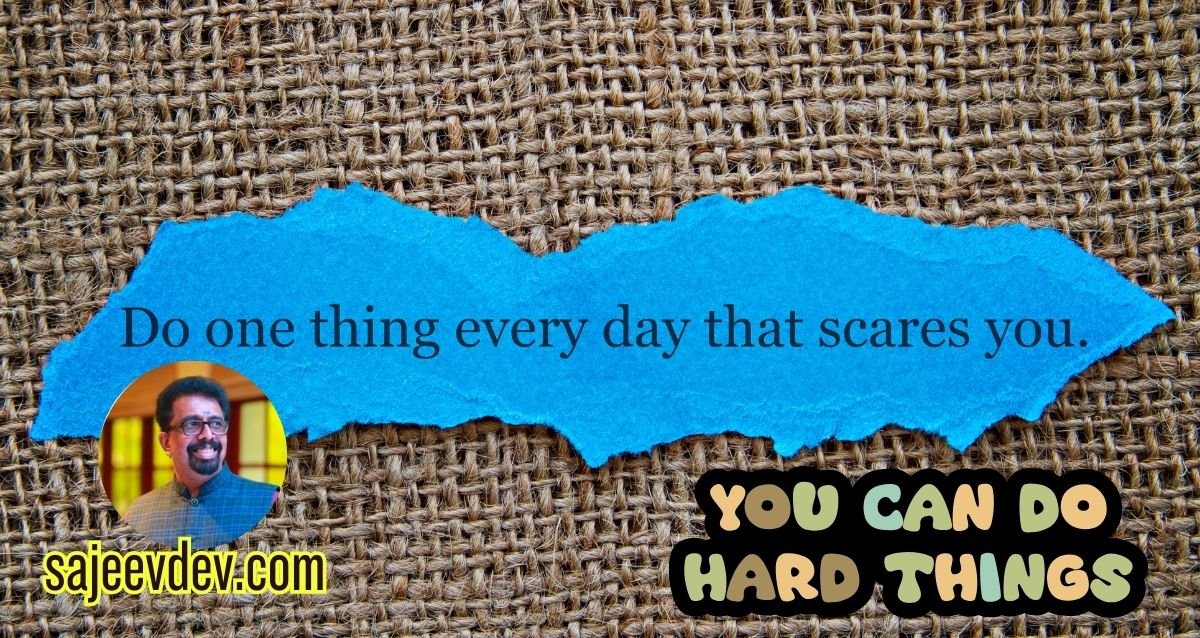The Concept
The notion of undertaking one challenging task each day that instills a sense of fear or discomfort is a concept that has gained substantial attention over the years. Often attributed to the esteemed Eleanor Roosevelt, the phrase encourages individuals to embrace fear as a catalyst for personal and professional growth. Roosevelt’s advocacy for facing fears stemmed from her belief that overcoming obstacles can lead to profound self-improvement and resilience. This idea emphasizes that fear, rather than being a deterrent, enhances the potential for transformative experiences.
Engaging in activities that provoke fear can serve as an effective way to step outside of established comfort zones. Comfort zones often provide a false sense of security and can stymie personal development. By challenging oneself daily, individuals create opportunities to learn, adapt, and thrive in various situations. Fear can significantly limit one’s aspirations, resulting in missed opportunities and a stagnant existence. Thus, by consciously recognizing and addressing these fears, one opens doors to new possibilities and experiences.
The practice of committing to a daily fear-inducing endeavor can manifest in several forms. Whether it involves public speaking, tackling a difficult conversation, or trying a new skill, the outcomes are typically rewarding. Over time, this practice fosters resilience and self-confidence. The repeated acts of courageousness inherently reshape one’s perception of fear, shifting it from a source of apprehension to a stepping stone for growth. Embracing fear in this manner nurtures a proactive mindset, cultivating a spirit of exploration and adventure that can greatly enrich one’s life.
Understanding Comfort Zones
Comfort zones are those psychological spaces where individuals feel safe, secure, and at ease. They encompass familiar routines, environments, and behaviors that minimize anxiety and risk. The allure of comfort zones lies primarily in their ability to provide predictability; when people stay within these areas, their experiences are typically manageable and devoid of significant challenges. This sense of safety is rooted in human psychology, where familiarity often equates to comfort.
However, while comfort zones can foster a sense of stability, prolonged residence in these spaces may lead to stagnation. Remaining within one’s comfort zone can inhibit personal growth and development. Individuals often miss out on valuable opportunities for learning and advancement as they resist engaging with new and potentially frightening experiences. The paradox here is that while comfort zones may offer short-term solace, they can also cultivate long-term limitations and hinder the pursuit of one’s full potential.
Additionally, the fear of the unknown often paralyzes individuals, compelling them to cling tightly to their comfort zones. This fear can manifest through various forms, such as anxiety about social interactions, reluctance to pursue new career paths, or avoidance of activities that challenge one’s skillset. Such avoidance behaviors highlight the psychological mechanisms at play, demonstrating how the mind prioritizes perceived safety over the benefits that come from stepping outside these familiar boundaries.
In acknowledging the risks of remaining too long within comfort zones, it becomes crucial to seek a balance that includes stepping outside of these areas regularly. Engaging in activities that induce a slight level of discomfort can lead to significant personal growth and open doors to opportunities that one may have otherwise forfeit. Recognizing the interplay between comfort and growth is essential in cultivating a mindset geared toward continuous improvement.
The Power of Fear
Fear is a fundamental human emotion that arises in response to perceived threats and challenges. It is often characterized as a negative experience, instilling feelings of anxiety and hesitation. However, understanding the nature of fear reveals its complexity and potential benefits in the context of personal development. Biologically, fear triggers the fight-or-flight response, activating specific brain regions such as the amygdala. This rapid response mechanism prepares individuals to confront dangers or retreat from them, but it can also create barriers when such responses are unhelpful in everyday scenarios.
Emotionally, fear can manifest as self-doubt, procrastination, or avoidance behaviors, inhibiting individuals from pursuing opportunities that foster growth. When fear dominates, it can prevent the exploration of new experiences, limiting both personal and professional advancement. Nonetheless, fear can also emerge as a powerful motivator. When carefully harnessed, it drives individuals out of their comfort zones, prompting them to take risks and embrace challenges that may result in significant rewards.
Recognizing fear as a natural part of human existence is the first step towards transforming it into a catalyst for change. For example, individuals might feel fear when considering public speaking, but confronting this anxiety can lead to enhanced communication skills and increased self-confidence over time. Similarly, fear of failure in professional settings may push individuals to refine their competencies, thus providing a pathway to success. By reframing the perception of fear, one can utilize it as a mechanism for growth and exploration rather than as a hindrance.
Ultimately, acknowledging and understanding fear can empower individuals to integrate it into their daily lives purposefully, prompting them to undertake one action each day that challenges their limits and facilitates personal evolution.
Benefits of Stepping Outside Your Comfort Zone
Stepping outside one’s comfort zone offers a multitude of benefits that contribute significantly to personal development. One of the most notable advantages is the facilitation of personal growth. Engaging in activities that elicit fear or discomfort allows individuals to confront their limitations and learn skills that may otherwise remain dormant. For instance, someone who fears public speaking might join a local speaking club, which can lead to improved communication skills, increased vocabulary, and more confidence in expressing ideas.
Additionally, pushing boundaries cultivates resilience. When faced with unfamiliar situations, individuals learn to navigate challenges and adapt accordingly. This not only enhances their problem-solving abilities but also strengthens their capacity to cope with future adversities. A classic example can be seen in individuals who take on adventurous pursuits, such as hiking or rock climbing, which demand quick thinking and adaptability in varying environments—activities that teach resilience as they confront physical and emotional challenges.
Moreover, enhanced confidence emerges as a crucial benefit. As individuals successfully tackle daunting tasks, their sense of accomplishment grows, leading to a more robust self-image. This newfound confidence often transcends the initial fear and impacts other areas of life. For instance, a timid employee who embraces the challenge of leading a project may discover leadership qualities they didn’t know they possessed, positively influencing their career trajectory.
Finally, stepping outside one’s comfort zone encourages a better ability to adapt to change. In today’s rapidly evolving world, adaptability is paramount. Individuals who actively seek out experiences beyond their sphere of comfort are often more open to change and better equipped to handle life’s uncertainties. The amalgamation of these benefits underscores the importance of embracing fear and discomfort as catalysts for personal development and lifelong learning.
Practical Tips for Getting Started
Stepping outside your comfort zone can be a daunting task; however, by employing practical strategies, you can begin to conquer your fears in a systematic manner. One effective approach is to set small, achievable goals that gradually lead to more significant challenges. By starting with manageable objectives, you can build confidence and develop a sense of accomplishment. For example, if public speaking is a fear, consider starting by sharing your thoughts in a small group setting, then gradually working up to larger audiences.
Another critical aspect of this journey is to identify specific fears you wish to tackle. Take the time to reflect on what genuinely frightens you and prioritize these fears to determine a manageable path forward. This process not only focuses your efforts but also helps you confront fears in a structured manner. When you clearly understand what you’re up against, you can devise actionable steps to overcome each fear.
Journaling about your experiences can also be incredibly valuable. Documenting your thoughts and feelings allows you to reflect on your progress, recognize patterns of thought, and understand your emotional responses. This practice can reveal breakthroughs in your journey as well as areas that need further exploration. Additionally, reviewing your journal entries can serve as motivation to continue challenging yourself.
Furthermore, finding accountability partners can enhance your journey of embracing fear. Connecting with a friend, family member, or mentor who encourages you to push your boundaries can provide invaluable support. These individuals can help you stay committed and celebrate your victories, no matter how small. By using these strategies, you can create a framework that allows you to safely venture out of your comfort zone, ultimately fostering personal growth and resilience.
Challenges and Overcoming Setbacks
Embarking on a journey to confront fears and step beyond one’s comfort zone is both commendable and fraught with challenges. Initially, individuals may experience a surge of enthusiasm; however, the reality of facing fears can introduce a range of emotional and psychological hurdles. Common challenges include anxiety, self-doubt, and the temptation to revert to familiar but unfulfilling patterns of behavior. It is essential to recognize that these feelings are a natural response to stepping into the unknown.
Setbacks are often an inevitable component of this transformative journey. For instance, one might confront a fear of public speaking only to find themselves unprepared during their first presentation. Rather than viewing such a failure as a definitive endpoint, individuals can benefit from shifting their perspective. Each setback presents an opportunity to learn, adapt, and refine strategies. Embracing a mindset that reframes failures as learning experiences fosters resilience—a critical trait for overcoming challenges.
The importance of resilience cannot be overstated. It propels individuals to face adversity with determination and persistence. By developing a growth mindset, individuals can cultivate the belief that their abilities and intelligence can be enhanced through effort and perseverance. This mindset encourages the understanding that discomfort and fear are not signs of weakness but rather integral components of personal development.
Moreover, surrounding oneself with a supportive community can significantly bolster one’s capacity to overcome challenges. Engaging with friends, mentors, or support groups allows individuals to share experiences, gain insights, and receive encouragement. Ultimately, recognizing that fears and setbacks are a natural part of the journey creates space for growth and enhances one’s ability to embrace the fear, one day at a time.
Inspiring Stories of Transformation
Many individuals have embarked on the journey of embracing fear, each discovering unique transformations that resonate deeply with their personal experiences. Take the story of Sarah, a graphic designer who had long battled social anxiety. Each day, she committed to initiating a conversation with a stranger—be it a barista or a fellow commuter. Initially, her heart raced at the thought, but over time, these interactions transformed into empowering moments that boosted her confidence significantly. Today, Sarah leads workshops on public speaking, inspiring others to confront their fears head-on.
Similarly, Mark, a software engineer, took on the challenge of performing open mic comedy. For years, he held a burning desire to express himself through humor but was often paralyzed by the fear of judgment. His daily commitment to perform, despite the initial discomfort, led to an unexpected transformation. Not only did Mark discover a passion for comedy, but he also learned to embrace vulnerability and connect with audiences, fostering a sense of community that he had long yearned for.
These stories exemplify how the act of confronting fear can lead to profound personal growth. Sarah and Mark are not alone; countless others have shared their stories of taking leaps of faith, whether it be through travel, networking, or exploring new hobbies. Each narrative highlights a common theme: the significance of discomfort as a catalyst for change. By actively choosing to face their fears, these individuals cultivated resilience, broadened their perspectives, and inspired others in the process.
As you consider what fears you may wish to confront, it may be encouraging to recognize that you are not alone in this journey. The stories of transformation illustrate that the path to self-discovery is paved with courageous choices and that each moment of discomfort can ultimately lead to remarkable growth.
Creating a 30-Day Challenge
Creating a 30-day challenge focused on confronting fears can be an enriching and transformative experience. To begin, identify specific fears that you wish to address. These could range from social anxieties, such as initiating conversations with strangers, to more personal challenges, like speaking in public or trying a new activity that feels intimidating. Once you have your list, select one fear to confront each day for a month.
Next, establish a clear framework for your challenge. You might consider maintaining a dedicated journal or digital document to track your progress. Each day should include the fear you are tackling, the action taken to confront it, and your feelings before and after the experience. This practice will not only help in documenting your journey but will also serve as a reflection tool to understand your emotional responses as you progress.
To encourage consistency, set reminders on your phone or create a calendar that outlines your daily goals. Celebrate each success, no matter how small, to cultivate a sense of accomplishment. This could be as simple as treating yourself to a favorite snack or engaging in a rewarding activity that you enjoy. Additionally, consider sharing your journey with friends or family, as their support can offer encouragement and motivation.
At the end of the 30 days, take time to reflect on your experiences. Analyze your journal entries and consider how your perceptions of these fears have shifted. You might discover that fears which once seemed insurmountable are now manageable. This process not only fosters personal growth but also empowers you to embrace new challenges in the future. Ultimately, this structured approach to tackling fears can become a valuable part of your daily routine, fostering resilience and personal development.
The Road Ahead
Embracing fear is not merely a phrase; it is a vital component of personal development. By committing to face one fear each day, individuals open themselves up to myriad opportunities for growth. This journey requires courage, reflection, and adaptability—qualities essential for navigating the complexities of life. As we confront our fears, we often find that they are not as daunting as they once appeared. Each small step taken towards overcoming these challenges reinforces resilience and builds a stronger character.
Moreover, engaging in this practice encourages self-discovery and empowers individuals to gain a deeper understanding of their motivations and aspirations. When we step outside of our comfort zones, we expose ourselves to new experiences, skills, and perspectives that can alter our life trajectories. Whether it is initiating a difficult conversation, trying out a new hobby, or taking a different route to work, these incremental changes can facilitate significant shifts in our mindset.
As you embark on this ongoing journey, consider documenting your experiences. This not only serves to track your progress but can also provide clarity on the fears you choose to confront. Sharing your stories can inspire others to embark on their paths to bravery. Online platforms and support groups can offer additional motivation and a sense of community for those facing similar challenges. Remember, each person’s journey is unique; the key is to challenge yourself consistently.
As we reflect on the importance of facing fears, let’s commit to pushing the boundaries of our comfort zones. Embrace the fear and transform it into an avenue for personal growth. The road ahead may seem uncertain at times, but the rewards of resilience, confidence, and self-awareness are worth every step. Take that first step today, and together, let us navigate the exhilarating path of embracing fear and seeking continual improvement.









